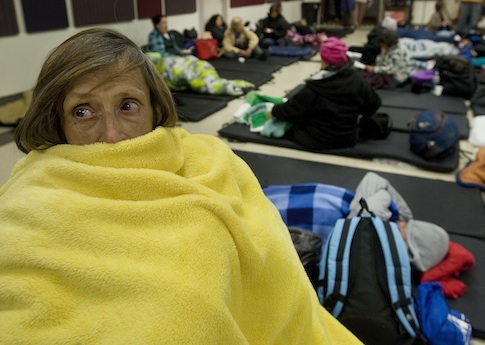The recent deaths of five homeless men due to hypothermia and reports of shelters being overwhelmed by those seeking a warm bed shows that the Obama administration has failed to combat an endemic problem, experts say.
Santa Clara County, Calif., reported the deaths of four homeless men late last week. County officials in a news conference said hypothermia "played a role in all the deaths" of the men, who were in their late 40s and 50s. Three of the men were found out in the elements, and the fourth was found in a garage with the door ajar.
Another man died the previous week in a Tent City in Lakewood, N.J., inhabited by the homeless. His death was due to hypothermia.
"The tragic news of people dying because they are living outside has hit us all very hard. Everyone is deeply saddened by this," said Jenny Niklaus, CEO of EHC LifeBuilders, in a statement. "Many of us, including me, are also angry. But we aren’t surprised. Because this is what happens when we allow homelessness in our community. People die."
The Obama administration adopted its Opening Doors strategy in 2010 to address homelessness. Key goals of the plan included ending chronic homelessness in five years, preventing and ending veteran homelessness in five years, and ending homelessness for families, youth, and children in 10 years.
The U.S. Conference of Mayors’ 2013 Hunger and Homelessness report is set to be released on Wednesday, December 11. Its focus will be on cuts to food stamps and veterans.
Last year’s report showed the total number of homeless across 25 of the surveyed cities increased by 7 percent. The report also cited city officials, who agreed with homeless advocates interviewed by the Free Beacon, on the leading cause of homelessness.
"City officials cited the lack of affordable housing as the leading cause of homelessness among families with children," the report stated. The other two leading causes were poverty and unemployment.
EHC is a nonprofit which operates eight housing and shelter sites across Santa Clara County. Claire Wagner, EHC’s communications manager, said the county has approximately 1,200 beds available at its shelters—far short of the 7,600 who are homeless in the county.
"We could never, ever be able to shelter everyone," Wagner said. Santa Clara County has seen its homeless population increase by 8 percent in the past two years. The City of San Jose has had an 18 percent increase during the same period.
To end homelessness, Wagner said the focus must be on finding affordable housing for those who live on the streets.
Silicon Valley, with the fifth largest homeless population in the country, also has a high cost of living, she said. That, coupled with a tight rental market in which the lower income cannot find affordable housing, is contributing to the county’s homeless problem.
"It is really difficult for people to find a place to live," Wagner said. Currently, approximately 75 people have Section 8 housing vouchers but cannot find an apartment because rents are higher than the voucher amount.
Minneapolis is also experiencing an increase in its homeless population and the Salvation Army has been dealing with more people coming into its shelters.
Annette Bauer, community relations director of the Salvation Army, said its Harbor House shelter is now providing a warm bed for approximately 600 people. In 2012, they sheltered 547 homeless; in 2011, they sheltered 495.
"When it’s very cold like this, they will come in," Bauer said, explaining that the homeless in the Twin Cities realize they must seek shelter in these freezing temperatures. The state has been dealing with bitter cold and wind chills of below zero.
The Salvation Army has now installed more bunk beds to accommodate additional people, according to Bauer. A chapel with mats is also now open so others can find shelter there. Hallways in the group’s shelters have also been filled to capacity, said Bauer.
"We don’t turn anyone away," Bauer said. More than a dozen local churches are now offering to house the homeless, and volunteers from the church are feeding them. Each church takes several days a week each, rotating to care for those without a home.
"The communities, especially local churches, are helping in circumstances for dire need," she explained.
"Our goal is to move them out, into some kind of housing, until they can recover," she said. "We are concentrating on getting homeless into housing."
However, like Santa Cara, the Twin Cities’ low-income rental market is tight. There is "nowhere to get people into," Bauer said, "right now, we have no affordable housing."
Other recent media reports show the homeless situation is dire. The homeless are overwhelming shelters in Boston, Baltimore is facing a challenge in dealing with its homeless, and Colorado’s homeless were left seeking shelter during a severe cold front gripping the state.
A new report shows a growing number of college students are now homeless. Some sleep in cars, others crash on friends’ couches, and one even slept in a computer lab closet.
The New York Times recently published a series on the problem of homelessness in America's "most unequal city," noting that there are "22,000 homeless children in New York, the highest number since the Great Depression."
The city's Department of Homeless Services reported a total of 50,926 people sought shelter, including 22,052 children, on December 6. These numbers do not include those in the city who are unsheltered.
The DHS, in a request for comment, referred the Free Beacon to its website.
